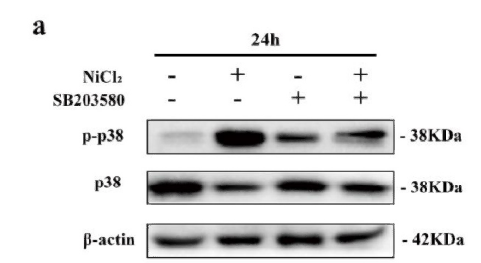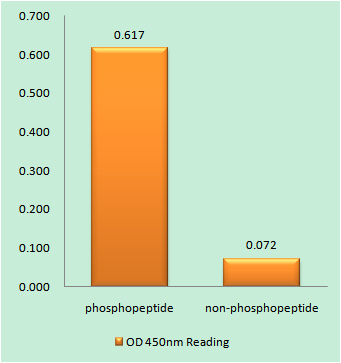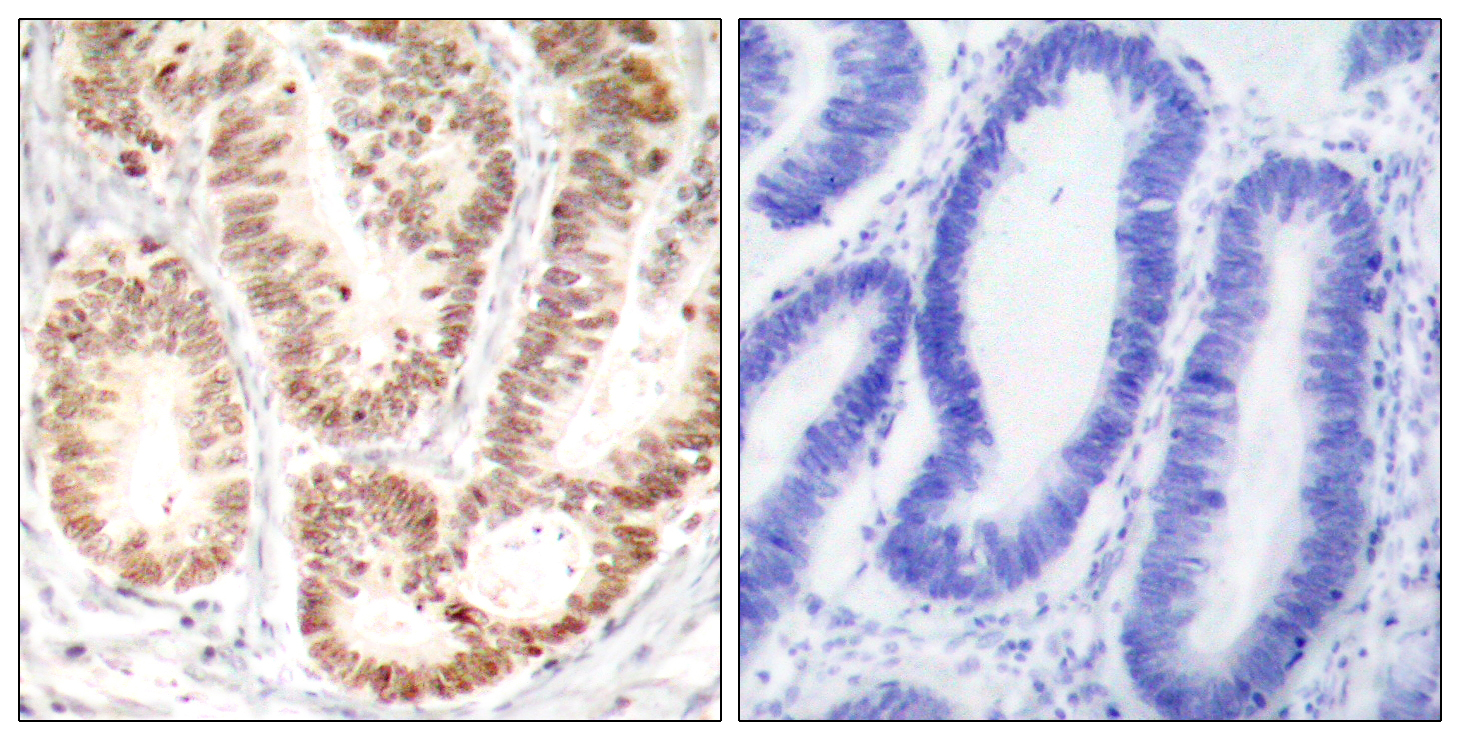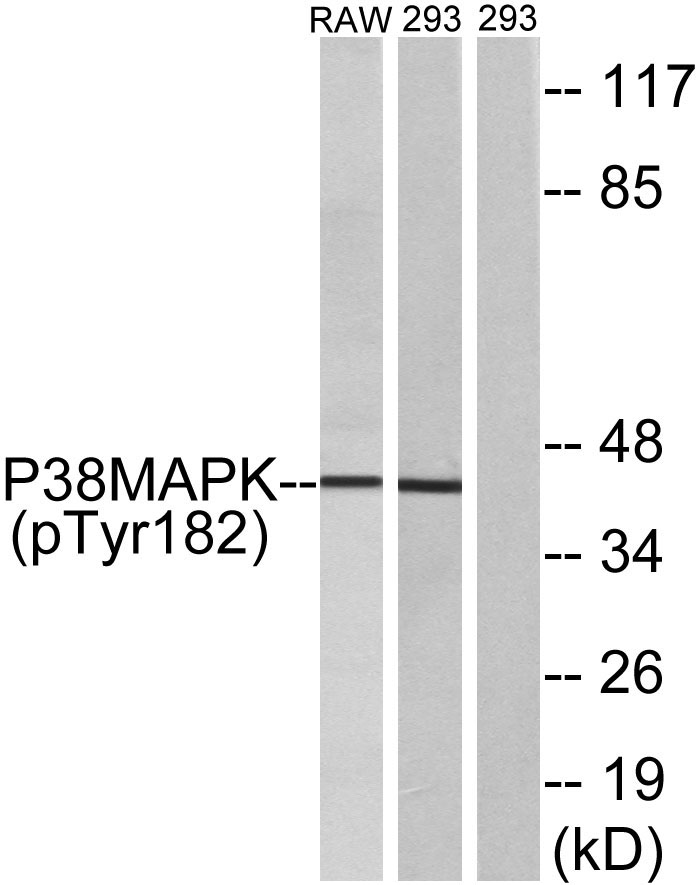p38 (phospho Tyr182) Polyclonal Antibody
- Catalog No.:YP0203
- Applications:WB;IHC;IF;ELISA
- Reactivity:Human;Mouse;Rat
- Target:
- p38
- Fields:
- >>Endocrine resistance;>>MAPK signaling pathway;>>Rap1 signaling pathway;>>FoxO signaling pathway;>>Sphingolipid signaling pathway;>>Oocyte meiosis;>>Cellular senescence;>>Adrenergic signaling in cardiomyocytes;>>VEGF signaling pathway;>>Osteoclast differentiation;>>Signaling pathways regulating pluripotency of stem cells;>>Platelet activation;>>Neutrophil extracellular trap formation;>>Toll-like receptor signaling pathway;>>NOD-like receptor signaling pathway;>>RIG-I-like receptor signaling pathway;>>C-type lectin receptor signaling pathway;>>IL-17 signaling pathway;>>Th1 and Th2 cell differentiation;>>Th17 cell differentiation;>>T cell receptor signaling pathway;>>Fc epsilon RI signaling pathway;>>TNF signaling pathway;>>Leukocyte transendothelial migration;>>Thermogenesis;>>Neurotrophin signaling pathway;>>Retrograde endocannabinoid signaling;>>Dopaminergic synapse;>>Inflammatory mediator regulation of TRP channels;>>GnRH signaling pathway;>>Progesterone-mediated oocyte maturation;>
- Gene Name:
- MAPK14
- Protein Name:
- Mitogen-activated protein kinase 14
- Human Gene Id:
- 1432
- Human Swiss Prot No:
- Q16539
- Mouse Gene Id:
- 26416
- Mouse Swiss Prot No:
- P47811
- Rat Swiss Prot No:
- P70618
- Immunogen:
- The antiserum was produced against synthesized peptide derived from human p38 MAPK around the phosphorylation site of Tyr182. AA range:147-196
- Specificity:
- Phospho-p38 (Y182) Polyclonal Antibody detects endogenous levels of p38 protein only when phosphorylated at Y182.
- Formulation:
- Liquid in PBS containing 50% glycerol, 0.5% BSA and 0.02% sodium azide.
- Source:
- Polyclonal, Rabbit,IgG
- Dilution:
- WB 1:500 - 1:2000. IHC 1:100 - 1:300. ELISA: 1:10000.. IF 1:50-200
- Purification:
- The antibody was affinity-purified from rabbit antiserum by affinity-chromatography using epitope-specific immunogen.
- Concentration:
- 1 mg/ml
- Storage Stability:
- -15°C to -25°C/1 year(Do not lower than -25°C)
- Other Name:
- MAPK14;CSBP;CSBP1;CSBP2;CSPB1;MXI2;SAPK2A;Mitogen-activated protein kinase 14;MAP kinase 14;MAPK 14;Cytokine suppressive anti-inflammatory drug-binding protein;CSAID-binding protein;CSBP;MAP kinase MXI2;MAX-interacting protein
- Observed Band(KD):
- 38kD
- Background:
- The protein encoded by this gene is a member of the MAP kinase family. MAP kinases act as an integration point for multiple biochemical signals, and are involved in a wide variety of cellular processes such as proliferation, differentiation, transcription regulation and development. This kinase is activated by various environmental stresses and proinflammatory cytokines. The activation requires its phosphorylation by MAP kinase kinases (MKKs), or its autophosphorylation triggered by the interaction of MAP3K7IP1/TAB1 protein with this kinase. The substrates of this kinase include transcription regulator ATF2, MEF2C, and MAX, cell cycle regulator CDC25B, and tumor suppressor p53, which suggest the roles of this kinase in stress related transcription and cell cycle regulation, as well as in genotoxic stress response. Four alternatively spliced transcript variants of this gene encoding d
- Function:
- catalytic activity:ATP + a protein = ADP + a phosphoprotein.,cofactor:Magnesium.,domain:The TXY motif contains the threonine and tyrosine residues whose phosphorylation activates the MAP kinases.,enzyme regulation:Activated by threonine and tyrosine phosphorylation by either of two dual specificity kinases, MAP2K3 or MAP2K6, and potentially also MAP2K4. Inhibited by dual specificity phosphatases, such as DUSP1. Specifically inhibited by the binding of pyridinyl-imidazole compounds, which are cytokine-suppressive anti-inflammatory drugs (CSAID). Isoform Mxi2 is 100-fold less sensitive to these agents than the other isoforms and is not inhibited by DUSP1. Isoform Exip is not activated by MAP2K6.,function:Responds to activation by environmental stress, pro-inflammatory cytokines and lipopolysaccharide (LPS) by phosphorylating a number of transcription factors, such as ELK1 and ATF2 and seve
- Subcellular Location:
- Cytoplasm . Nucleus .
- Expression:
- Brain, heart, placenta, pancreas and skeletal muscle. Expressed to a lesser extent in lung, liver and kidney.
Telekin suppresses human hepatocellular carcinoma cells in vitro by inducing G 2 /M phase arrest via the p38 MAPK signaling pathway. ACTA PHARMACOLOGICA SINICA Acta Pharmacol Sin. 2014 Sep;35(10):1311-1322 WB Human HepG2 cell
Telekin suppresses human hepatocellular carcinoma cells in vitro by inducing G 2 /M phase arrest via the p38 MAPK signaling pathway. ACTA PHARMACOLOGICA SINICA Acta Pharmacol Sin. 2014 Sep;35(10):1311-1322 WB Human HepG2 cell
Astragalus Polysaccharide Eases G1 Phase-Correlative Bystander Effects through Mediation of TGF-βR/MAPK/ROS Signal Pathway After Carbon Ion Irradiation in BMSCs. AMERICAN JOURNAL OF CHINESE MEDICINE Am J Chinese Med. 2019 May;47(03):595-612 WB Human BMSCs
Icariin inhibits MMP‑1, MMP‑3 and MMP‑13 expression through MAPK pathways in IL‑1β‑stimulated SW1353 chondrosarcoma cells. Molecular Medicine Reports 2017 May 01 WB Human 1:1000 SW1353 cell
The analgesic effects of β-elemene in rats with neuropathic pain by inhibition of spinal astrocytic ERK activation: Molecular Pain Jin Zheng WB Rat
Nickel induces blood-testis barrier damage through ROS-mediated p38 MAPK pathways in mice. Redox Biology Hongrui Guo WB Mouse testis tissue TM4 cell
- June 19-2018
- WESTERN IMMUNOBLOTTING PROTOCOL
- June 19-2018
- IMMUNOHISTOCHEMISTRY-PARAFFIN PROTOCOL
- June 19-2018
- IMMUNOFLUORESCENCE PROTOCOL
- September 08-2020
- FLOW-CYTOMEYRT-PROTOCOL
- May 20-2022
- Cell-Based ELISA│解您多样本WB检测之困扰
- July 13-2018
- CELL-BASED-ELISA-PROTOCOL-FOR-ACETYL-PROTEIN
- July 13-2018
- CELL-BASED-ELISA-PROTOCOL-FOR-PHOSPHO-PROTEIN
- July 13-2018
- Antibody-FAQs
- Products Images

- Nickel induces blood-testis barrier damage through ROS-mediated p38 MAPK pathways in mice. Redox Biology Hongrui Guo IF,WB Mouse testis tissue TM4 cell

- Li, Lin, et al. "Telekin suppresses human hepatocellular carcinoma cells in vitro by inducing G 2/M phase arrest via the p38 MAPK signaling pathway." Acta Pharmacologica Sinica 35.10 (2014): 1311.

- Western blot analysis of lysates from 1) PC-3, 2) MCF-7 cells, (Green) primary antibody was diluted at 1:1000, 4°over night, Dylight 800 secondary antibody(Immunoway:RS23920)was diluted at 1:10000, 37° 1hour. (Red) Tubulin β Monoclonal Antibody(5G3) (Immunoway:YM3030) antibody was diluted at 1:5000 as loading control, 4° over night,Dylight 680 secondary antibody(Immunoway:RS23710)was diluted at 1:10000, 37° 1hour.

- Enzyme-Linked Immunosorbent Assay (Phospho-ELISA) for Immunogen Phosphopeptide (Phospho-left) and Non-Phosphopeptide (Phospho-right), using p38 MAPK (Phospho-Tyr182) Antibody

- Immunohistochemistry analysis of paraffin-embedded human colon carcinoma, using p38 MAPK (Phospho-Tyr182) Antibody. The picture on the right is blocked with the phospho peptide.

- Western blot analysis of lysates from RAW264.7 cells and 293 cells, using p38 MAPK (Phospho-Tyr182) Antibody. The lane on the right is blocked with the phospho peptide.



